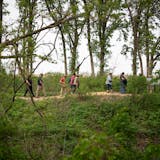Motorists who drive on Interstate 35W in south Minneapolis likely will be celebrating — and maybe even honking their horns, too — on Sept. 10. That's when the Minnesota Department of Transportation says it will be done with the massive rebuilding of the freeway that has shifted traffic around for the past four years.
"It's been a long haul and people are anxious for the reopening," south Minneapolis resident Teresa Erickson said in an e-mail in which she asked how much longer she'll have to dodge orange cones.
Before COVID-19, Erickson and her husband rode Metro Transit express buses to downtown Minneapolis but have driven more often since the pandemic started because many express routes were cut and have yet to return. Driving has hardly been smooth sailing.
"We hop on 35 to downtown at the 46th Street entrance," she said. "The highway is one lane for us until it joins up with two other lanes at approximately Lake Street. The drive home was pretty miserable until they reopened the southbound entrance at 4th Avenue."
Things are changing almost daily between Interstate 94 and 43rd Street as the $240 million overhaul enters the home stretch. And there is still plenty to do over the next two months, said MnDOT construction engineer Steven Barrett.
Motorists will have to endure one more weekend closure. The freeway will be shut down in both directions between downtown Minneapolis and Crosstown Hwy. 62 from the night of July 9 to the morning of July 12 to allow crews to switch traffic onto new lanes, "setting the stage for the final wrap up," Barrett said.
With some lanes still out of service, don't expect ramps leading to and from I-35W — such as those at Lake, 31st and 35th streets — to open until the last minute, Barrett said. "We won't have the lane capacity to bring on a lot of ramps," he said.
That includes a new flyover bridge that will carry northbound I-35W traffic to westbound I-94. When that opens, motorists will have to adjust to a big change as they enter westbound I-94 in their own lane on the left side of the freeway. With the old ramp, drivers crossed over I-94 then entered on the right side of the freeway and were forced to merge into traffic, said MnDOT spokesman David Aeikens.
![Three weeks ago, Octavio Rodriguez switched from making transmission parts to casting parts for hospital bed brake assemblies at Twin City Die Castings. ] GLEN STUBBE • glen.stubbe@startribune.com Thursday, April 9, 2020 How employee-owned Twin City Die Casting, which just laid off 40 production workers of its 250 employees in what was supposed to be a good year, is trying to accelerate its pivot to growing medical parts business for ventilators, hospital beds, etc as it copes with instan](https://arc.stimg.co/startribunemedia/WNZYKGTZ5IYMUCO3KI5TR3N7WI.jpg?&w=80&ar=1:1&fit=crop)
djoles@startribune.com As boaters flock to Minnesota lakes and rivers this holiday weekend for the unofficial kick-off to the boating season, they'll face more inspections in and out of the water as local cities and counties ramp up their work to stop the spread of invasive species. Across the metro, more boat accesses will be staffed by watercraft inspectors thanks to $10 million funneled to county government programs this year, up from $4.5 million the state allocated last year. ORG XMIT: MIN1505222156290209 ORG XMIT: MIN1506021218440580](https://arc.stimg.co/startribunemedia/34QSKO44B2XKVNUZCO5SLJQSLY.jpg?&w=80&ar=1:1&fit=crop)

